YAMAHA VIKING 2014 Owners Manual
Manufacturer: YAMAHA, Model Year: 2014, Model line: VIKING, Model: YAMAHA VIKING 2014Pages: 180, PDF Size: 3.78 MB
Page 141 of 180
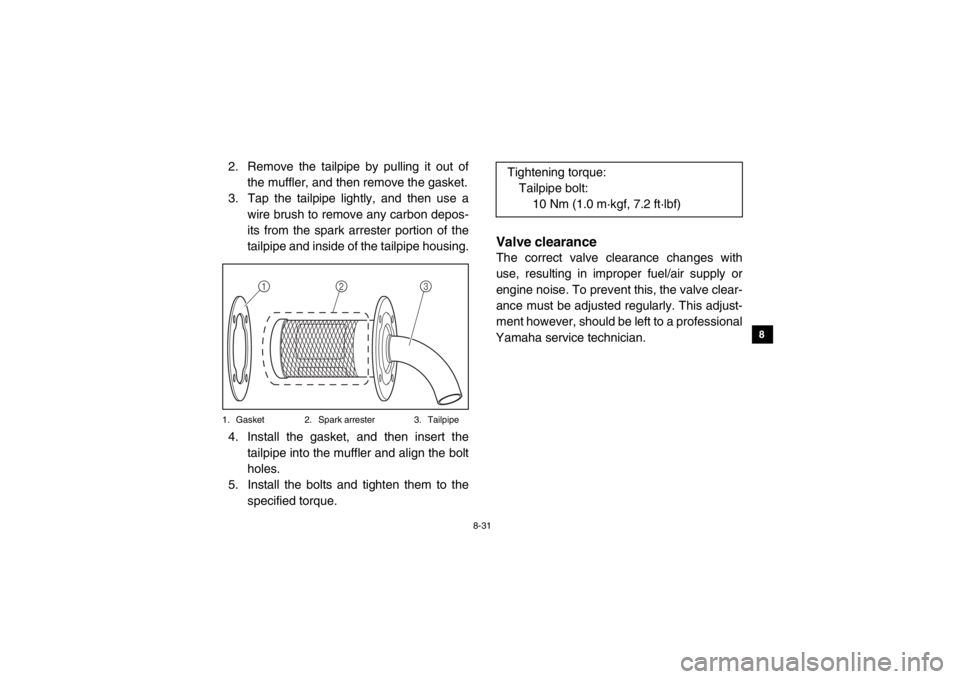
8-31
1
2
3
4
5
6
78
9
10
11
12
13
14
2. Remove the tailpipe by pulling it out ofthe muffler, and then remove the gasket.
3. Tap the tailpipe lightly, and then use a
wire brush to remove any carbon depos-
its from the spark arrester portion of the
tailpipe and inside of the tailpipe housing.1. Gasket 2. Spark arrester 3. Tailpipe4. Install the gasket, and then insert thetailpipe into the muffler and align the bolt
holes.
5. Install the bolts and tighten them to the specified torque.
Valve clearanceThe correct valve clearance changes with
use, resulting in improper fuel/air supply or
engine noise. To prevent this, the valve clear-
ance must be adjusted regularly. This adjust-
ment however, should be left to a professional
Yamaha service technician.
3
2
1
Tightening torque:
Tailpipe bolt:
10 Nm (1.0 m·kgf, 7.2 ft·lbf)
1XP7B_EE.book Page 31 Tuesday, February 4, 2014 3:40 PM
Page 142 of 180
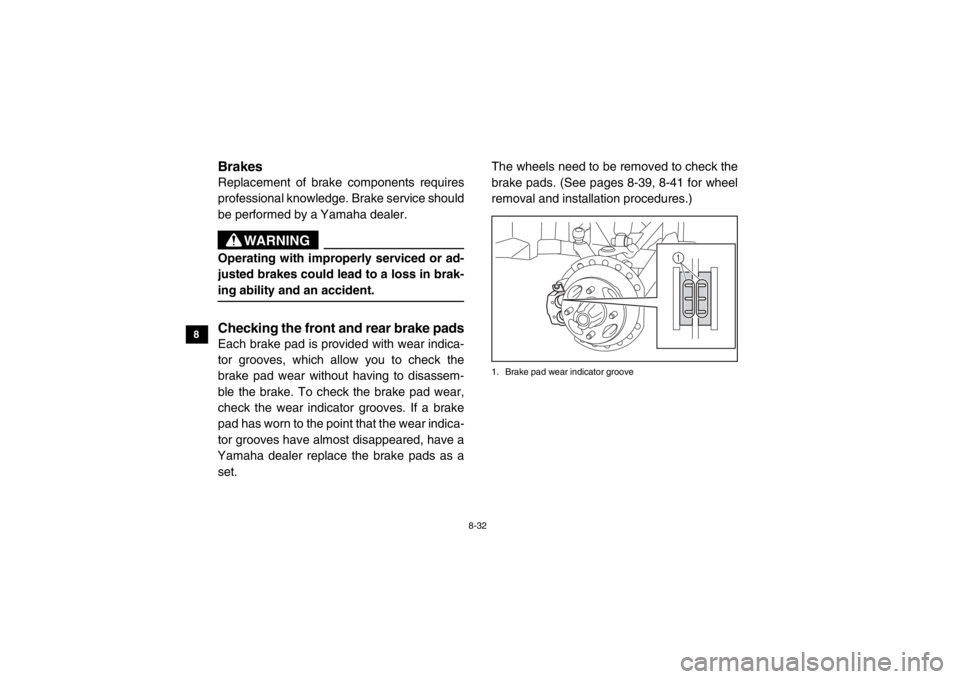
8-32
8
9
10
11
12
13
14
BrakesReplacement of brake components requires
professional knowledge. Brake service should
be performed by a Yamaha dealer.
WARNING
Operating with improperly serviced or ad-
justed brakes could lead to a loss in brak-
ing ability and an accident.5B410019Checking the front and rear brake padsEach brake pad is provided with wear indica-
tor grooves, which allow you to check the
brake pad wear without having to disassem-
ble the brake. To check the brake pad wear,
check the wear indicator grooves. If a brake
pad has worn to the point that the wear indica-
tor grooves have almost disappeared, have a
Yamaha dealer replace the brake pads as a
set. The wheels need to be removed to check the
brake pads. (See pages 8-39, 8-41 for wheel
removal and installation procedures.)
1. Brake pad wear indicator groove
1
1XP7B_EE.book Page 32 Tuesday, February 4, 2014 3:40 PM
Page 143 of 180
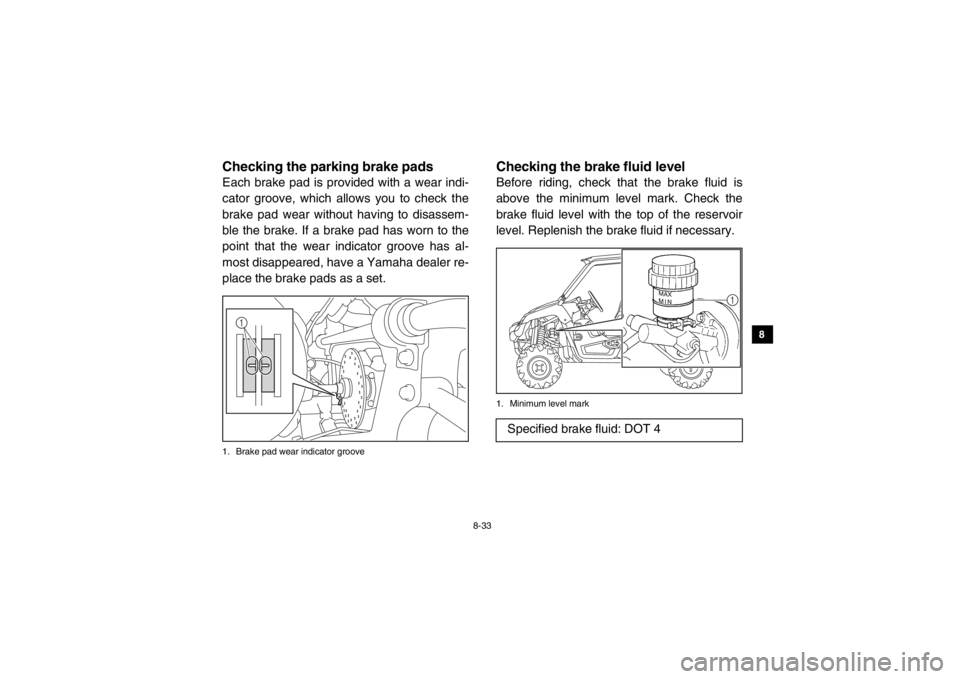
8-33
1
2
3
4
5
6
78
9
10
11
12
13
14
5B410020Checking the parking brake padsEach brake pad is provided with a wear indi-
cator groove, which allows you to check the
brake pad wear without having to disassem-
ble the brake. If a brake pad has worn to the
point that the wear indicator groove has al-
most disappeared, have a Yamaha dealer re-
place the brake pads as a set.1. Brake pad wear indicator groove
EVU00850Checking the brake fluid levelBefore riding, check that the brake fluid is
above the minimum level mark. Check the
brake fluid level with the top of the reservoir
level. Replenish the brake fluid if necessary.1. Minimum level mark
1
Specified brake fluid: DOT 4
1
1XP7B_EE.book Page 33 Tuesday, February 4, 2014 3:40 PM
Page 144 of 180
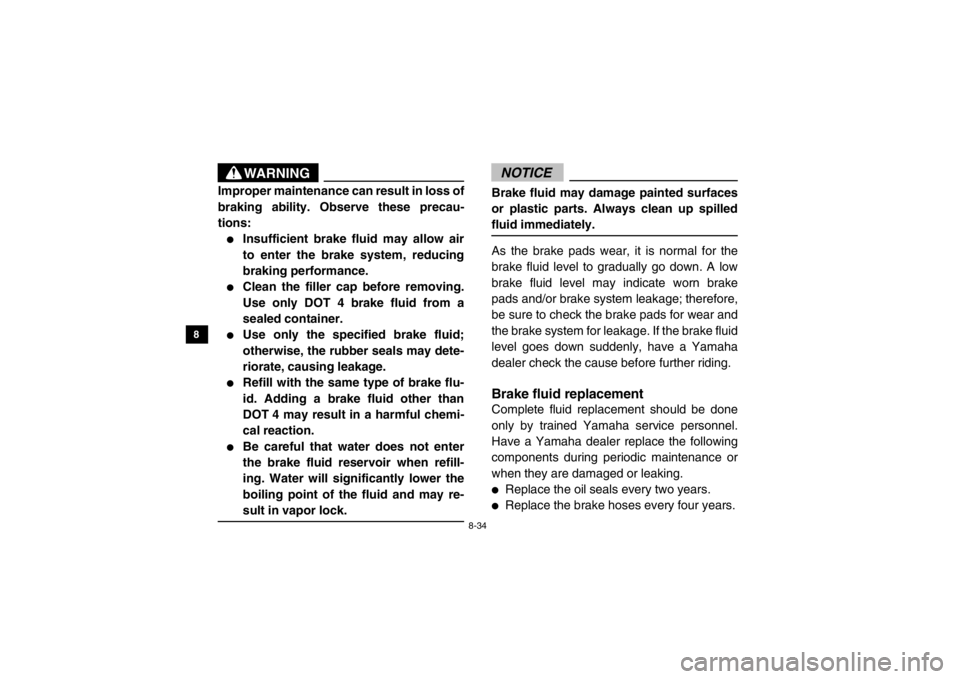
8-34
8
9
10
11
12
13
14
WARNING
Improper maintenance can result in loss of
braking ability. Observe these precau-
tions:●
Insufficient brake fluid may allow air
to enter the brake system, reducing
braking performance.
●
Clean the filler cap before removing.
Use only DOT 4 brake fluid from a
sealed container.
●
Use only the specified brake fluid;
otherwise, the rubber seals may dete-
riorate, causing leakage.
●
Refill with the same type of brake flu-
id. Adding a brake fluid other than
DOT 4 may result in a harmful chemi-
cal reaction.
●
Be careful that water does not enter
the brake fluid reservoir when refill-
ing. Water will significantly lower the
boiling point of the fluid and may re-
sult in vapor lock.
NOTICEBrake fluid may damage painted surfaces
or plastic parts. Always clean up spilled
fluid immediately.As the brake pads wear, it is normal for the
brake fluid level to gradually go down. A low
brake fluid level may indicate worn brake
pads and/or brake system leakage; therefore,
be sure to check the brake pads for wear and
the brake system for leakage. If the brake fluid
level goes down suddenly, have a Yamaha
dealer check the cause before further riding.EVU00860Brake fluid replacementComplete fluid replacement should be done
only by trained Yamaha service personnel.
Have a Yamaha dealer replace the following
components during periodic maintenance or
when they are damaged or leaking.●
Replace the oil seals every two years.
●
Replace the brake hoses every four years.
1XP7B_EE.book Page 34 Tuesday, February 4, 2014 3:40 PM
Page 145 of 180
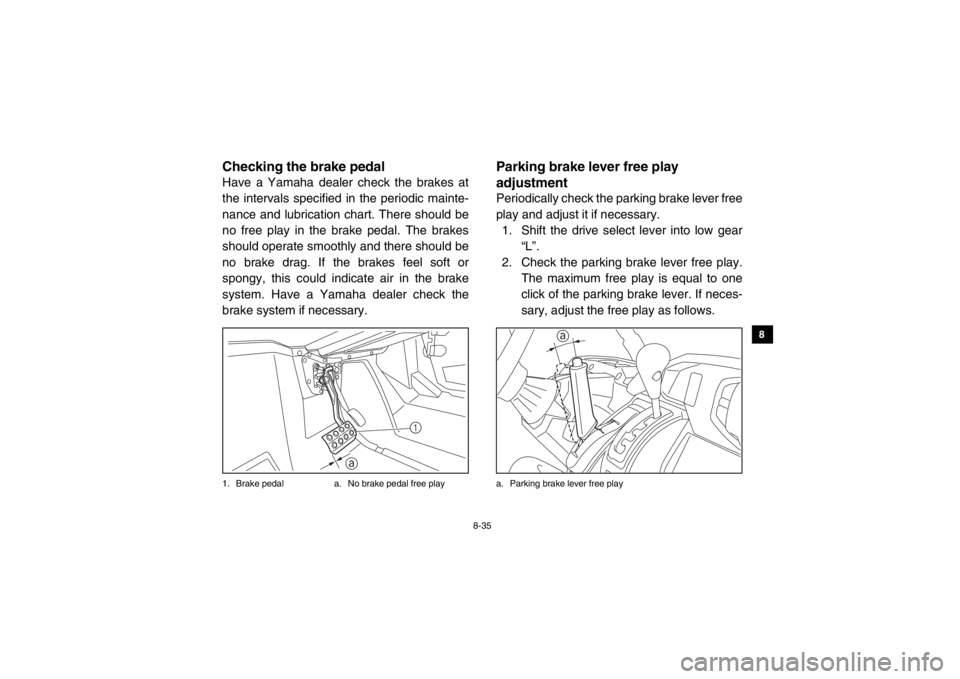
8-35
1
2
3
4
5
6
78
9
10
11
12
13
14
EVU01220Checking the brake pedalHave a Yamaha dealer check the brakes at
the intervals specified in the periodic mainte-
nance and lubrication chart. There should be
no free play in the brake pedal. The brakes
should operate smoothly and there should be
no brake drag. If the brakes feel soft or
spongy, this could indicate air in the brake
system. Have a Yamaha dealer check the
brake system if necessary.1. Brake pedal a. No brake pedal free play
EVU00870Parking brake lever free play
adjustmentPeriodically check the parking brake lever free
play and adjust it if necessary.
1. Shift the drive select lever into low gear “L”.
2. Check the parking brake lever free play. The maximum free play is equal to one
click of the parking brake lever. If neces-
sary, adjust the free play as follows.a. Parking brake lever free play
1
a
a
1XP7B_EE.book Page 35 Tuesday, February 4, 2014 3:40 PM
Page 146 of 180
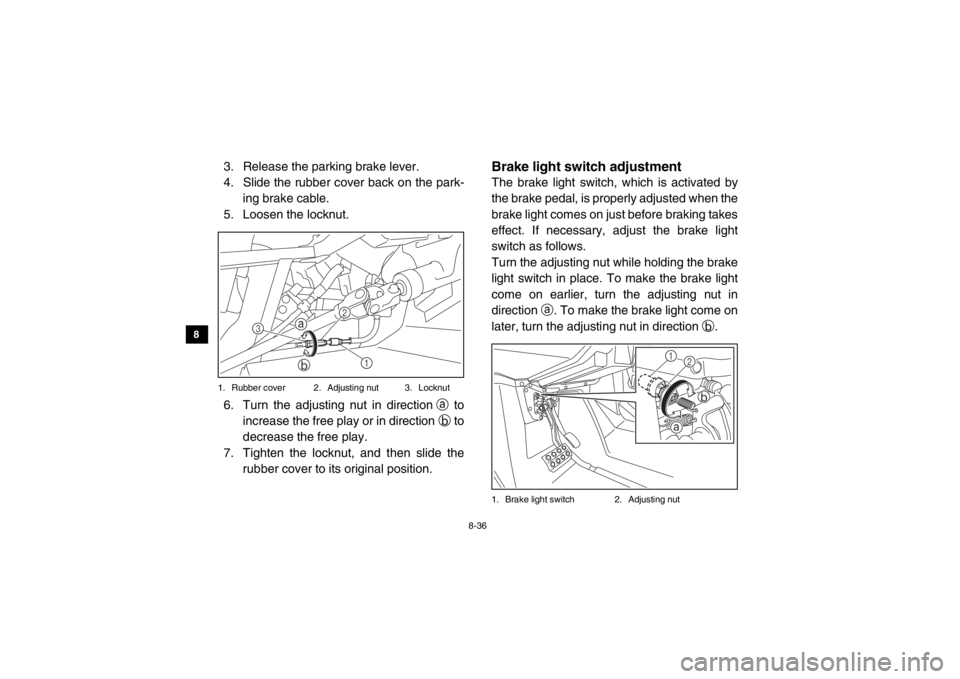
8-36
8
9
10
11
12
13
14
3. Release the parking brake lever.
4. Slide the rubber cover back on the park- ing brake cable.
5. Loosen the locknut.1. Rubber cover 2. Adjusting nut 3. Locknut6. Turn the adjusting nut in direction a to
increase the free play or in direction b to
decrease the free play.
7. Tighten the locknut, and then slide the rubber cover to its original position.
EVU00880Brake light switch adjustmentThe brake light switch, which is activated by
the brake pedal, is properly adjusted when the
brake light comes on just before braking takes
effect. If necessary, adjust the brake light
switch as follows.
Turn the adjusting nut while holding the brake
light switch in place. To make the brake light
come on earlier, turn the adjusting nut in
direction a. To make the brake light come on
later, turn the adjusting nut in direction b.1. Brake light switch 2. Adjusting nut
1
ab
2
3
1a
b
2
1XP7B_EE.book Page 36 Tuesday, February 4, 2014 3:40 PM
Page 147 of 180
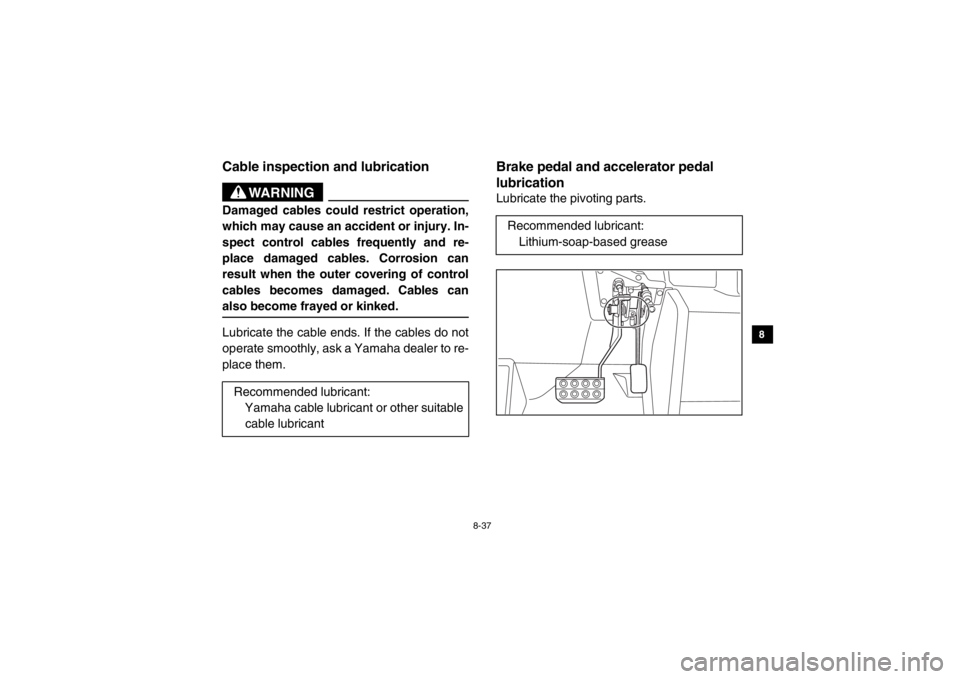
8-37
1
2
3
4
5
6
78
9
10
11
12
13
14
EVU00890Cable inspection and lubrication
WARNING
Damaged cables could restrict operation,
which may cause an accident or injury. In-
spect control cables frequently and re-
place damaged cables. Corrosion can
result when the outer covering of control
cables becomes damaged. Cables can
also become frayed or kinked.Lubricate the cable ends. If the cables do not
operate smoothly, ask a Yamaha dealer to re-
place them.
EVU00900Brake pedal and accelerator pedal
lubricationLubricate the pivoting parts.
Recommended lubricant: Yamaha cable lubricant or other suitable
cable lubricantRecommended lubricant: Lithium-soap-based grease
1XP7B_EE.book Page 37 Tuesday, February 4, 2014 3:40 PM
Page 148 of 180
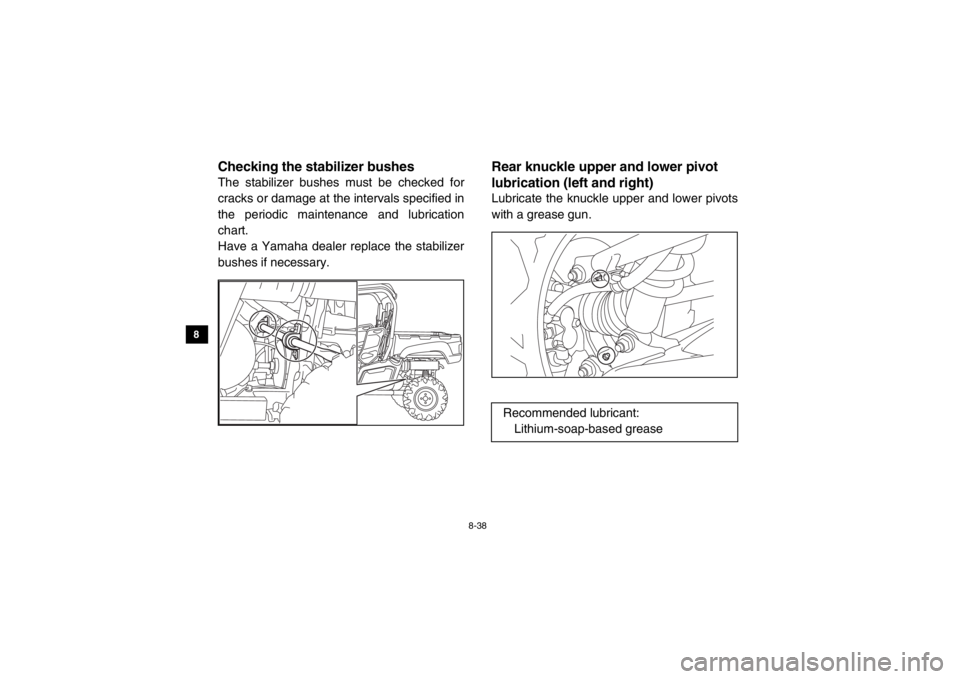
8-38
8
9
10
11
12
13
14
Checking the stabilizer bushesThe stabilizer bushes must be checked for
cracks or damage at the intervals specified in
the periodic maintenance and lubrication
chart.
Have a Yamaha dealer replace the stabilizer
bushes if necessary.
5B410021Rear knuckle upper and lower pivot
lubrication (left and right)Lubricate the knuckle upper and lower pivots
with a grease gun.
Recommended lubricant:
Lithium-soap-based grease
1XP7B_EE.book Page 38 Tuesday, February 4, 2014 3:40 PM
Page 149 of 180
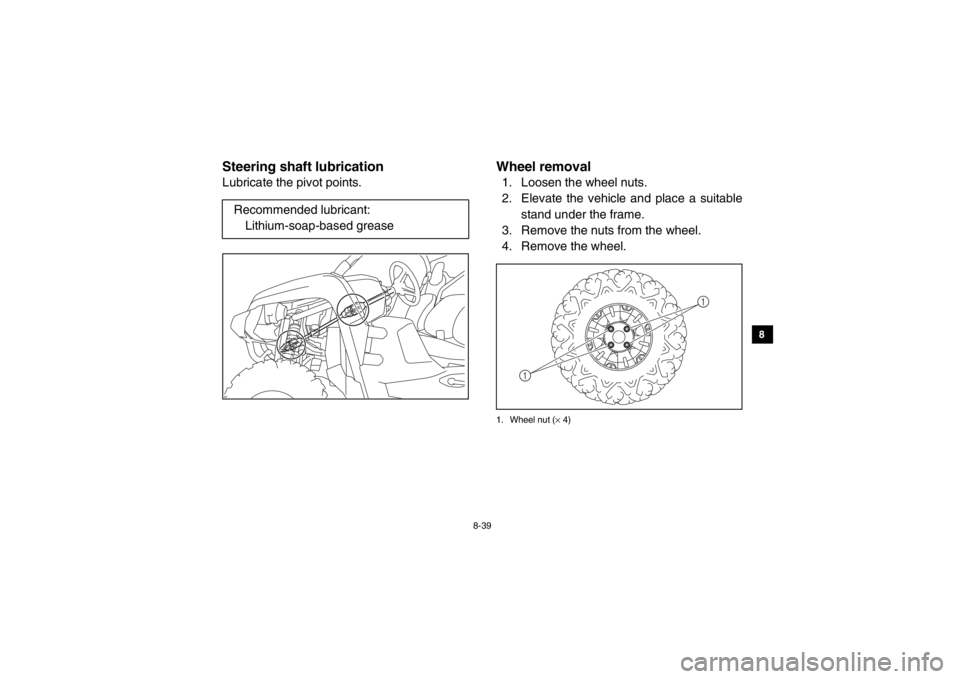
8-39
1
2
3
4
5
6
78
9
10
11
12
13
14
EVU00920Steering shaft lubricationLubricate the pivot points.
EVU00930Wheel removal1. Loosen the wheel nuts.
2. Elevate the vehicle and place a suitablestand under the frame.
3. Remove the nuts from the wheel.
4. Remove the wheel.1. Wheel nut ( × 4)
Recommended lubricant:
Lithium-soap-based grease
1
1
1XP7B_EE.book Page 39 Tuesday, February 4, 2014 3:40 PM
Page 150 of 180
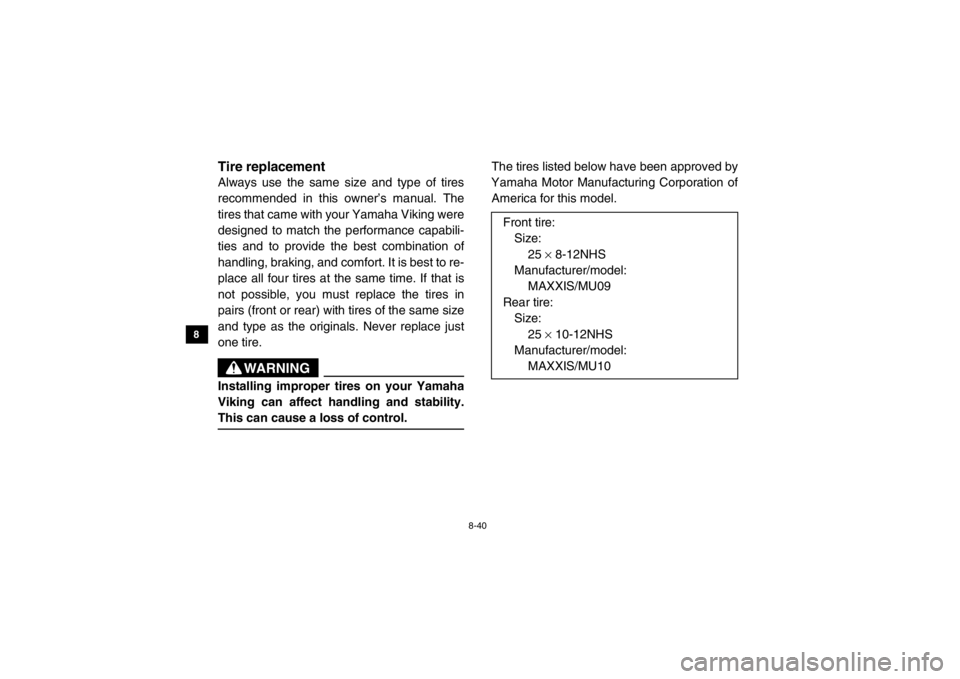
8-40
8
9
10
11
12
13
14
Tire replacementAlways use the same size and type of tires
recommended in this owner’s manual. The
tires that came with your Yamaha Viking were
designed to match the performance capabili-
ties and to provide the best combination of
handling, braking, and comfort. It is best to re-
place all four tires at the same time. If that is
not possible, you must replace the tires in
pairs (front or rear) with tires of the same size
and type as the originals. Never replace just
one tire.
WARNING
Installing improper tires on your Yamaha
Viking can affect handling and stability.
This can cause a loss of control.
The tires listed below have been approved by
Yamaha Motor Manufacturing Corporation of America for this model.
Front tire:Size: 25 × 8-12NHS
Manufacturer/model:
MAXXIS/MU09
Rear tire: Size:
25 × 10-12NHS
Manufacturer/model: MAXXIS/MU10
1XP7B_EE.book Page 40 Tuesday, February 4, 2014 3:40 PM